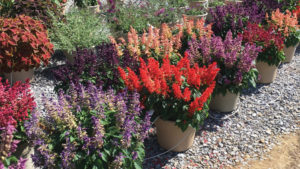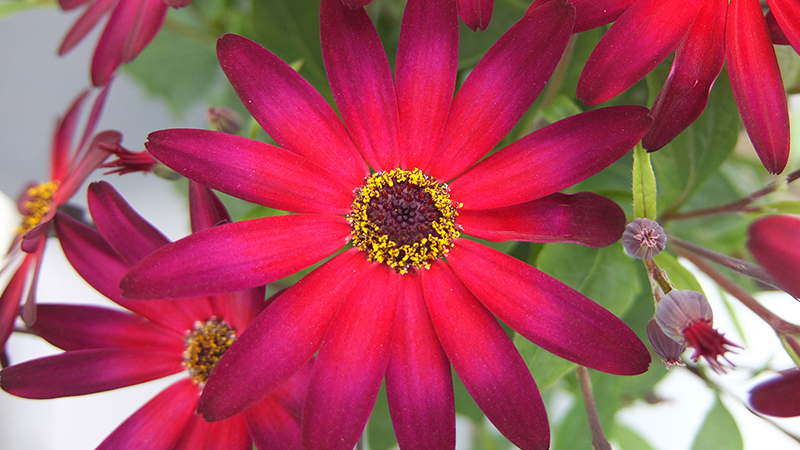Kelly Norris: How The “Me Too” Philosophy Affects Plant Breeding

Combinations in GardenGenetics’ trial gardens at Bellefonte, PA.
Psychologist Jean Twenge coined the phrase “Generation Me” in her book of the same title, originally published in 2006. The book makes a case for how the rise of the millennial generation has shifted and restructured American society in nearly all respects, in some cases for better and others for worse. One bold quip in particular is thematic — “ditch the self-esteem movement.” In other words, we must stop holding the value of one’s self higher than what we actually achieve or accomplish.
The green industry has been bombarded with similar themes of constant improvement for much of the last seven years, throughout and following the Great Recession. Engage young consumers. Ask them what they want. Connect with them on their own terms and on the platforms where they live. Talk the talk, walk the walk — be authentic. Yada, yada, yada, says this millennial. I’m an optimist (Dr. Twenge wouldn’t be the least bit surprised, since most Millennials are), so I’d like to think by now that we get it.
The current state of new plant development suggests otherwise. Think about the resources we invest in defining and upholding the value of brands. Everybody has one; everybody needs one to survive.
But isn’t that thinking exactly the kind of selfish mindset that leads to disillusionment when the results don’t easily materialize? Think of the competition for attention that we invest in so heavily and the near constant articulation of what makes anything different compared to the 30 other things out there just like it.
If you think you have an original idea, a Google search can probably suggest otherwise. Come to think of it, that sounds exactly like the struggle to define new varieties for most consumers, who are numb to the seeming minutia of it all. By my accounting, we have lots of brands, lots of products, and stagnant per capita consumption. If this is our industry’s existential (20-something) crisis, our timing couldn’t be better.
Nothing New Under The Sun?
Where does that leave new product development? Dr. Rick Grazzini, Executive Director of GardenGenetics, says his company approaches innovation with a graphic design analogy.
“We think of existing varieties and markets as the positive space. We try to breed to the negative space or to the holes or openings in the marketspace,” he says.
As far as articulating those opportunities, Grazzini says that most questions breeders need to ask themselves have less to do with technical considerations than they do with sales and marketing.
“The breeding is always easier to do than getting the new plant out the door,” he says.
In a saturated marketplace, getting the plant out the door is steep enough.
“When we started GardenGenetics, we were encouraged to breed calibrachoa,” Grazzini says. “After five years, we stopped. It had become obvious to us that no matter how good our me-too calibrachoa breeding was, we were simply fishing in the same pond as everyone else,” he says.
But Really … Me Too!
The self-awareness of GardenGenetics’ decision in this instance seems almost academic in today’s marketplace. Why even pursue a product development strategy at the risk of being labeled “me too?” The only real answer is that you as a product developer have to believe in and deliver a product that users really like or will like more than an existing product on the market. It’s easy enough to toss off the criticism that the market is flooded with me-too genetics. But which products really solve problems for the end user in the best way?
Dan Heims, President of Terra Nova Nurseries, says he places a value on creative solutions that impact gardeners. Terra Nova is long credited with developing heuchera as a new category. Yet, while other companies, in the competitive, capitalistic spirit, have tried to add value to the marketplace, the real question is how consumers perceive it.
“There tends to be a little too much product pushing,” Heims says, speaking of a recent introduction of a heuchera from another company. “If the best photo of your product is only from a four-inch pot, have you really tested the plant to see what it will look like?”
Apart from what a plant does or doesn’t do for consumers, you have to wonder why anyone would want to gamble with the odds of already slim margins in a marketplace with structural limitations, on a product not easily differentiated from its competition. Plant breeding is expensive.
What’s It Worth?
Grazzini says breeders, particularly those working independently of a large firm, have to think strategically about product positioning.
“If your business strategy as an independent breeder includes licensing products to one of the multinational, vertically integrated corporations that dominate our industry, realize that it will be very difficult to compete with their internal breeding,” Grazzini says.
Those firms also have the marketing capacity to compete.
“It’s easy for companies with me-too genetics to promote a plant because they have the marketing machine,” Heims says.
His criticism is on point — the brand or platform reigns, regardless of what it does.
“What it does instead, is fill the world with inferior plants and stifles creativity,” he says.









